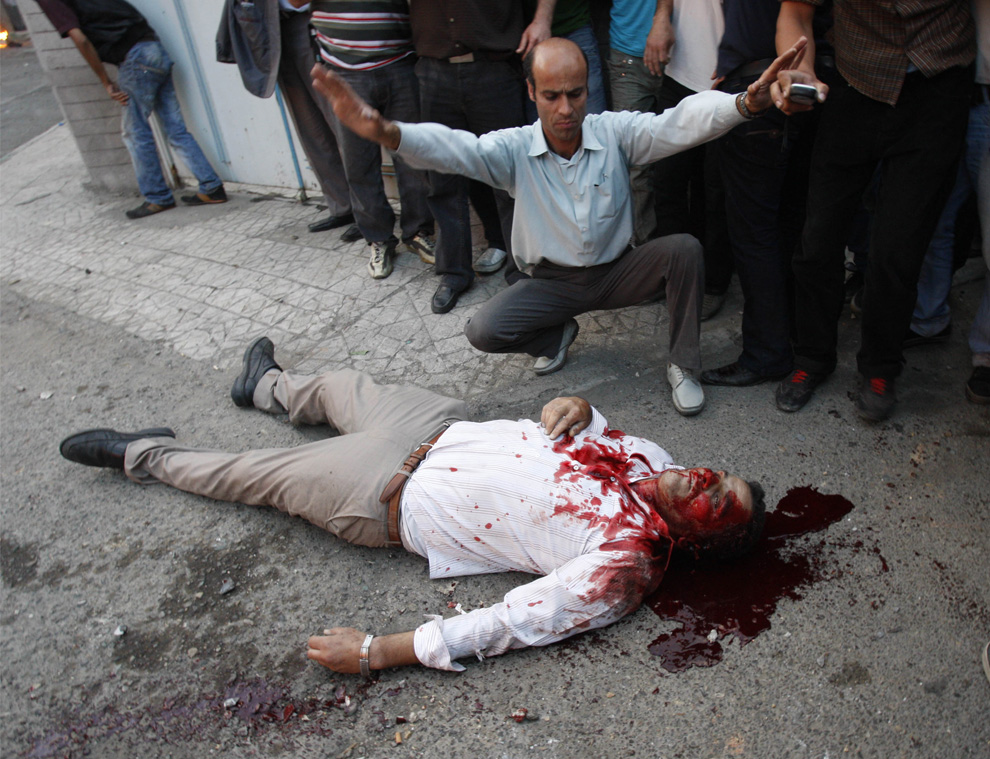Cohen explains how the recent election protests have revealed the inherent contradictions in Iranian society: between an entrenched, isolationist, autocratic theocracy and a technologically savvy, inherently democratic and cosmopolitan generation that came of age since the Islamic Revolution of 1979. The situation as the lines are drawn in the sand "isn't pretty", but could be the harbinger of real change in Iran.
The End of the Beginning
By ROGER COHEN
Published: June 23, 2009
TEHRAN — Iran’s 1979 revolution took a full year to gestate. The uprising of 2009 has now ended its first phase. But the volatility ushered in by the June 12 ballot-box putsch of Iran’s New Right is certain to endure over the coming year. The Islamic Republic has been weakened.

During one of the violent clashes here in recent days, I saw a member of the riot police confront a protester holding a cell phone. “Don’t take a photograph of me!” he yelled at the young man.
“Why?” the man shouted back. “You’re not naked.”
But the Islamic Republic is. Everyone knows where everyone stands; it isn’t pretty. All the fudge that allowed a modern society to coexist with a theocracy inspired by an imam occulted in the 9th century has been swept away, leaving two Irans at war.
One of those Irans, embodied in the 12-member Guardian Council, the highest legal body, ruled in a preliminary statement on Tuesday that “no major fraud” had occurred in the vote and that its annulment was therefore impossible. Not much surprise there, in that Ayatollah Ali Khamenei, the supreme leader, made clear last week that the recount was a waste of time.
Of course, the definition of “major” is up for debate. Khamenei himself said rigging one million votes might be feasible, and the council found irregularities with three million votes.
But numbers have ceased to mean anything here. All the evidence is that percentages were simply allotted to each candidate and the votes cast backward-engineered from there. The Interior Ministry took 10 days to divulge results for all provinces. Such engineering takes time.
Iran has squandered a huge opportunity to bridge the gulf between the regime and an increasingly sophisticated population thirsting for greater freedom. A vibrant election campaign opened a door. It has been slammed shut.
“The Islamic Republic is the flag-bearer of human rights,” Khamenei declared in his Friday sermon. Over the past week, it has looked more like a flag-bearing police state.
True, the regime has not opened fire Tiananmen Square-style on the millions who have taken to the streets. I don’t believe it has the unity to do that. Significant cracks have emerged within the establishment, certainly the largest since the bloody first couple of years after the revolution. Relentless official attacks on foreign agents as the instigators of unrest have not papered over these divisions.
As the Association of Combatant Clergy, which represents more liberal mullahs in Qom, said in a statement: “What sane mind believes that a peaceful movement of millions of informed people — including workers, shopkeepers, farmers, students, clergy and others — could be agents of a so-called enemy?”
I said the Islamic Republic has been weakened. Why? I see five principal factors. The first is that the supreme leader’s post — the apex of the structure conceived by the revolutionary leader Ayatollah Ruhollah Khomeini — has been undermined. The keystone of the arch is now loose.
Khamenei, far from an arbiter with a Prophet-like authority, has looked more like a ruthless infighter. His word has been defied. At night, from rooftops, I’ve even heard people call for his death. The unthinkable has occurred.
The second is that the hypocritical but effective contract that bound society has been broken. The regime never had active support from more than 20 percent of the population. But acquiescence was secured by using only highly targeted repression (leaving the majority free to go about its business), and by giving people a vote for the president every four years.
That’s over. Repression will be broad and ferocious in the coming months. The acquiescent have already become the angry. You can’t turn Iran into Burma: The resistance of a society this varied and savvy will be fierce.
The third is that a faction loyal to President Mahmoud Ahmadinejad, fiercely nationalistic and mystically religious, has made a power grab so bold that fissures in the establishment have become canyons.
Members of this faction include Hassan Taeb, the leader of the Basiji militia; Saeed Jalili, the head of the National Security Council and chief nuclear negotiator; and Mojtaba Khamenei, the reclusive but influential son of the supreme leader.
They have their way for now, but the cost to Iran has been immense, and the rearguard action led by Ali Akbar Hashemi Rafsanjani, a father of the revolution, and Mir Hussein Moussavi, the opposition leader, will be intense.
The fourth is that Iran’s international rhetoric, effective in Ahmadinejad’s first term, will be far less so now. Every time he talks of justice and ethics, his two favorite words, video will roll of Neda Agha Soltan’s murder and the regime’s truncheon-wielding goons at work. The president may prove too much of a liability to preserve.
The fifth is that, at the very peak of its post-revolution population boom, the regime has lost a whole new generation — and particularly the women of that generation — by failing to adapt.
Thirty years from the revolution, the core question of this election was: Must Iran stand apart from the forces of economic and political globalization in order to preserve its Islamic theocracy?
Or is it confident enough of its Islamic identity, and its now firmly established independence from America, to trash the nest-of-spies vitriol and an ultimately self-defeating isolation?
The answer has been devastating.
